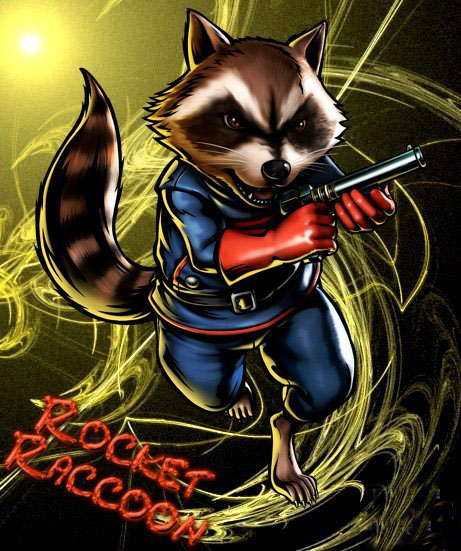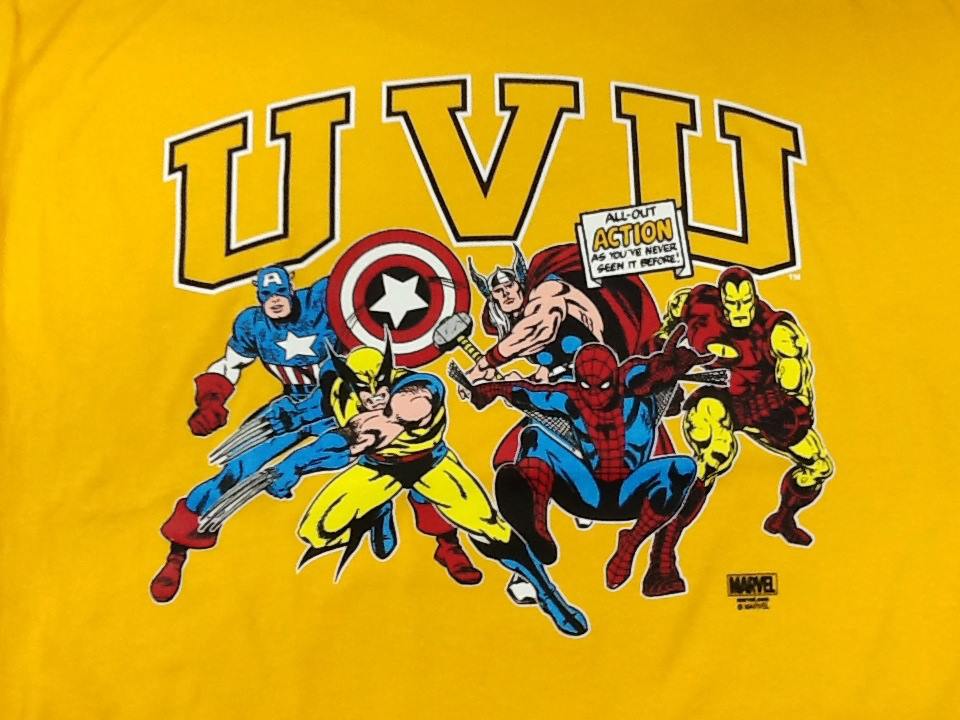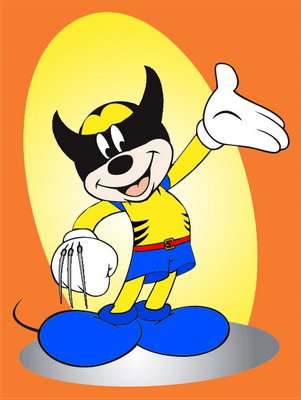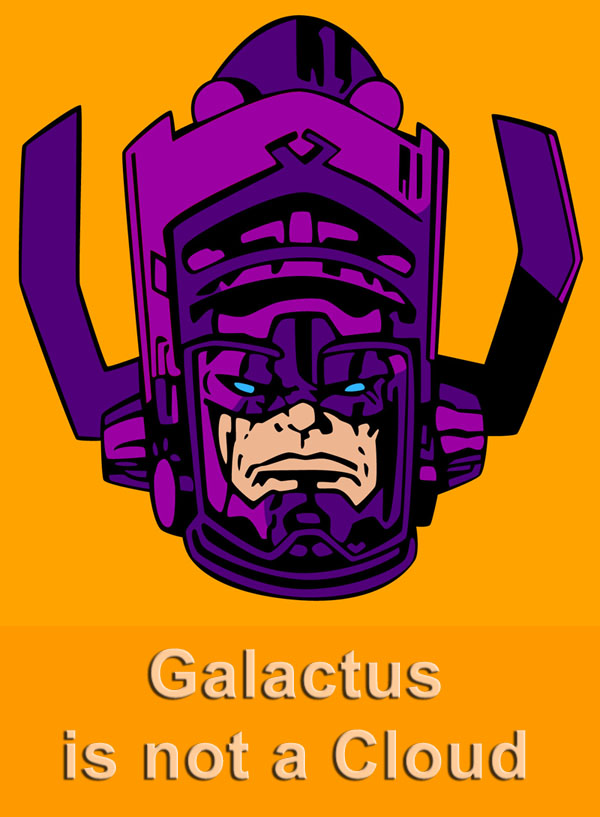Mark D. Pepper, Utah Valley University
(Published: Feb. 9, 2015)
“DC/WB is all like ‘Wonder Woman’s too confusing for a movie!’ and Marvel/Disney is all like ‘Here’s a raccoon with a machine gun’” –Brett White, Tweet, 12 Aug. 2013
On August 12, 2013, comedy writer Brett White posted this tweet, which aptly sums up the state of popular culture’s current obsession with superhero movies. Since 2008’s Iron Man, Marvel Studios has released an increasingly successful run of movies, culling from seventy-five years’ worth of material. As detailed in Sean Howe’s Marvel Comics: The Untold Story, these movies saved the company from bankruptcy and gave superheroes their widest audience since the Silver Age of comics in the 1960s and 1970s. Meanwhile, rival company DC Comics has struggled on the silver screen. Though Christopher Nolan’s Batman films are often cited as pinnacle works in the genre, flops like Catwoman and Green Lantern leave no doubt as to which company is winning the current race to put anything with superpowers on a screen. As White’s tweet illustrates, Marvel is so confident that they released Guardians of the Galaxy in August 2014—a movie based on a relatively unknown and low-selling comics series that, yes, features a talking raccoon with a penchant for automatic weaponry. Meanwhile, DC did finally get around to announcing a Wonder Woman movie in October 2014 (for a 2017 release). However, without the good will that Marvel has built, fan forums are already filled with skepticism regarding DC’s ability to handle such an iconic superhero figure.

Figure 1: Rocket Raccoon.
Despite my lifetime of comic fandom, I don’t have a problem with millions of people finally catching superhero fever. As a pop-culture theorist, I don’t automatically see popularity itself—even late-blooming popularity—as a sign of cultural studies’ favorite mustache-twirling villains, inauthenticity and commodification, wreaking havoc on my potentially liberated and authentic life. Sure, blockbuster movies and increased licensing deals have made commodification a superhero’s true power. But these superheroes are commodities and they always have been. Even superheroes from so-called “indie” publishers like Dark Horse and Eclipse are technically commodities. Easing into a discussion of post-postmodernism: everything is a commodity, but that’s only the starting place.
As Jeffrey T. Nealon writes about popular music, “music most assuredly is a commodity” (which can be just as true for superheroes), but it will always also be “all kinds of things in addition to being a commodity” (48-49). Nealon rejects the still thriving (in some places) “culture industry” argument about passively duped cultural consumers and states, “We’ve learned from several decades of crucial work in cultural studies that the word ‘commodity’ is no longer simply a fighting word” (50). I’ve always considered Gary Clarke’s work on the over-glorification of subcultural practices, “Defending Ski-Jumpers,” as a crucial part of the history of cultural studies. Clarke states, “I can see little point in any analysis which worships the innovators yet condemns those youth who appropriate that style when it becomes a market product…. [W]e ought to focus on the moment when the style becomes available—either as a commodity or as an idea to be copied” (173). Foregoing analysis or instantly condemning something simply because it is a popular commodity instantly dismisses the meaningful practices of millions.
For superheroes, that moment has definitely arrived. There have been more than thirty superhero movies from Marvel and DC since 2000, and this number doesn’t factor in movies like Hancock or Hellboy that feature superheroes without ties to the big two companies. College students now wear Marvel superheroes on university-licensed t-shirts to show school spirit. Knowing what happens to Spider-Man’s Gwen Stacey borders on common knowledge. Millions of people know who Iron Man is—before Robert Downey, Jr., a B-list superhero if there ever was one. And behind all of these releases, of course, is money—lots and lots of money that could mark superhero movies as another site to critique with the “fighting word” of commodification.

Figure 2: A UVU Marvel licensed t-shirt.
However, in Nealon’s explication of the post-postmodern condition, he suggests any discussion that begins by simply dismissing a cultural object for its commodified status will miss the mark precisely because capitalism’s present cultural commodification of everything is one defining factor of what makes culture, well, culture. Post-postmodernism “marks an intensification and mutation within postmodernism” and a change in the very function of capitalism, as Frederic Jameson described (Nealon ix). So in order to write current cultural theory, we need to realize postmodernism has “mutated [and] passed beyond a certain tipping point to become something recognizably different in its contours and workings” (Nealon ix). So this superhero trend is more than just a matter of superheroes making more money or enjoying wider fame. Both the commodification and current popularity of superheroes provides an opportunity to interrogate how these films reflect the “intensifications” and “mutations” that Nealon suggests define our current historical, social, and economic moment. Doing so can provide the genesis for discussing popular culture in a manner that isn’t over-obsessed with textual features while simultaneously reflecting the current economic climate of capitalism in which it’s produced and consumed.
Replace the word “commodity” in Nealon’s argument with “popular” (which should be an easy mental task since the two words are so often viewed as synonymous) and I think the advice still holds. Superhero movies are popular; however, they are much more than just popular. And like commodities, popular trends are rarely best served by treating that popularity as a “fighting word” against lowest-common-denominator homogeneity. Finally, as with commodification, understanding popularity itself seems like the best question to place this superhero boom in a meaningful post-postmodern context. However, why something becomes popular is still a question that, ironically, pop-culture studies often ignores.
This last point was perhaps best suggested by Lawrence Grossberg, who wrote, “When it is at all considered, popular culture is treated as if it were either high art—amenable to the same kinds of critical concerns and practices as the more institutionally sanctioned forms of culture—or documentary evidence—as if its status as popular were insignificant to its active insertion into the lives of people” (177). Twenty-five years after that observation, the broader implications of popularity itself still often take a back seat to dissecting pop-culture texts’ semantic and interpretive implications. There is plenty of superhero scholarship out there if this is a path you wish to follow. Peter Coogan’s Superhero: The Secret Origin of a Genre suggests superheroes “stand as metaphors for freedom—the freedom to act without consequences … [and] the restrictions of gravity, the law, families, and romantic relationships” (14). Coogan further suggests superheroes function as our culture’s modern-day mythology (124). This modern-day mythology thesis is more fully explored in Ben Saunders’ Do The Gods Wear Capes?, and Saunders appeared at the 2012 San Diego Comic-Con to explain how superheroes are merely the latest iteration of Jungian archetypes (Stevenson).
I’m uncomfortable with these approaches to the study of popular culture, though, because they seem to offer a preferred read for the audience instead of looking at how popularity is achieved and experienced in specific historical/economic contexts. This is not written to perpetuate the image of a duped and uncritical consumer; surely audiences are quite capable of making the mythological and metaphorical connections in their superhero movies. But audience savviness is exactly part of the problem with cultural studies continuing to work this angle. As Nealon points out, “Think of Roland Barthes's ‘Death of the Author’ or Judith Butler's gender performativity: these are no longer concepts that you have to laboriously sell to freshman. They already know this stuff; in fact, they live it…. [These] are no longer ‘emergent’ phenomenon, but they've become the ‘dominant’ ones” (64). Likewise, with popular sources from Salon to the Huffington Post, even Buzzfeed, increasingly offering pop-culture analysis in the veins of both close reading and liberatory politics, the continuing use of these tactics in scholarly work on pop culture is anything but radical or a specialized function of the academic institution (even when it’s done incredibly well).
Pointing to mythology and metaphors inside superhero movies doesn’t explain why people are flocking to them at this moment. “Consumers love modern mythology” doesn’t feel like a productive answer. Likewise, deconstructing problems with gender or racial inequality in superhero films (like DC’s long-standing fear of Wonder Woman or Marvel’s current slate of zero female-led films) is certainly important, but even those theoretical approaches don’t explain why this cultural moment is dominated by superheroes and what that might mean. Even a totally practical observation about CGI’s ever-increasing ability to render superhero spectacle on screen doesn’t explain why this brand of spectacle seems so appealing. The beginning of an answer to superhero film popularity must both use a method that factors in the new economic reality of our post-postmodern condition and interrogate our long-standing values of liberatory politics.
A central thesis of Nealon’s work is that capitalism and markets no longer work the way they did in the 1980s and 1990s. For most of the twentieth century, companies didn’t obsess over their stock price or the need to keep stockholders pleased. Pre-1980, the long-term and steady growth of a company was key, partially fueled by Keynesian economic principles that suggested demand constantly fluctuates with economic growth rates instead of demand consistently outweighing supply. Therefore, fluctuation in unemployment numbers and disposable income were seen as affecting demand and calling for caution. Pleasing a stockholder was bad business because a focus on quarterly numbers created a “what-have-you-done-for-me-lately mind-set rather than a long term pattern of quarterly growth” (Nealon 17). Caution ruled because steady growth was the best way to maintain profits and maximize expansion.
Nealon points to the ‘80s as the point when the market morphed from this into a “secular monotheism” that paved the path for corporatization with the mantras “downsize, outsource, keep the stock price high” (3)—mantras and practices that led into the 1990s’ “pro-business, market-take-all ethos” (10). The Fordist model of making capital from goods and services, and the post-Fordist model of slowly cultivating new iterations of services, gradually turned corporate values away from pleasing consumers towards pleasing shareholders. 1980s and 1990s mergers, acquisitions, and buyouts sought to cut the fat from inefficient companies and subsequently moved away from a model that maximized profits for all toward a mentality that the people who take the risk, the shareholders, are most entitled to the profits. Though it’s tempting to view high-profile crackdowns on companies like Enron and WorldCom in the early 2000s as comeuppance for increasing inequality and abuse in corporate America, these were not spurred by unions or employees; rather, shareholders themselves turned on CEOs. As Nealon points out, this was just another victory for shareholder power: “it most assuredly was not the result of a populist revolt against fat cats” (20).
These economic shifts map quite cleanly onto Marvel Comics’ history. Marvel, originally called Timely Publications, began in 1939 under the guidance of Marvin Goodman. Goodman had his various comics published by different corporations, all in the same building, to diversify the wealth and improve his odds of market expansion (Daniels 27). Though it’s difficult to identify exactly how many titles were on the market per decade, Howe’s tale of Marvel’s history points to a steady increase of available titles that finally reached its peak in the ‘90s. Though Marvel’s stock price was high at the start of the 1990s, investor and owner Ronald Perelman started issuing junk bonds to acquire other media companies (“Marvel Reaches”). Slow, steady growth had propelled Marvel’s sales over the decades, but success and greed lead to the eventual market oversaturation of the 1990s. Oversaturation, combined with Perelman’s practices, caused Marvel’s stock to drop by 60% in 1993 (Howe 356), and by 1996 the company filed for bankruptcy. The now all-mighty shareholders had once again punished a company for failing to fill their pockets. Eventually, Marvel was able to come out of bankruptcy and save itself through some final old-timey capitalist moves: expansion and mergers. Realizing that comic books would probably never again sell like they did in their heyday, Marvel entered the movie business, partnered with Fox and Sony, and finally merged with the Walt Disney Company in 2009 (those all-important Marvel shareholders received thirty dollars and 0.754 shares in Disney for each share of Marvel) (Wilkerson).

Figure 3: Wolverine Micky.
Now Marvel Studios closely follows Nealon’s model of post-postmodern capitalism. The result of a shareholder-takes-all mentality is that “[c]apitalism today seeks primarily to saturate and deepen—intensify—its hold over existing markets, insofar as global capitalism of the twenty-first century has run out of new territories to conquer” (Nealon 26). The newly risen Marvel easily owns the superhero-film market and really has nowhere else to go because they also dominate in other media like video games, toys, and even a modest renaissance in actual comic sales. The stagnation that can come with conquering doesn’t please a shareholder, so all that’s left is to intensify the market hold they currently enjoy. Intensification is not the creation of radical difference, and, although I love many of these movies, I can’t argue that they offer a lot of variety. They all follow somewhat predictable paths. So with the market dominated and little innovation in the genre, all that comic companies can do is intensify the experience of their movies in at least two ways. First, they can intensify the visceral spectacle. Iron Man has to switch between multiple suits of armor in part three. Spider-Man has to fight multiple villains (and plot bloat) as his sequels continue. The Fantastic Four go from fighting their megalomaniacal ex-friend to battling a cloud (yeah) that threatens the whole Earth. Even over at DC, Superman, usually a Boy Scout, has to level half of Metropolis and even kill his antagonist. Second, they can intensify the narrative by creating connections across their movies, which effectively creates a shared world that makes each individual release feel both larger and necessary if viewers are to keep up. With The Avengers, Marvel pulled off the unprecedented feat of combining six major characters from previously separate blockbusters into a juggernaut of anticipation, hype, and the desire for more. No film better demonstrates superhero films’ alluring draw through “the sheer spectacle of their symbolic excesses” and a demonstration of the “logics of intensity and speculation” (Nealon 28).

Figure 4: The real Galactus (not a cloud).
Nealon is not even talking about superheroes in that last quote. He’s referring to Las Vegas but asks a question just as relevant to superhero films: “What do you get for a crowd that has already experienced everything? The answer: more of the same” (30). Nealon suggests,
Las Vegas’s current modes of power are no longer primarily deployed in the service of legitimizing the enterprise or overcoming an enemy (the government, the middle-American prude, the other casinos); those battles have already been decided. Rather, emergent modes of both corporate and subjective power in Vegas are aimed at intensifying what you’ve already got … by deploying new forms of value-added entertainment “experiences.” (30)
Similarly, Marvel and DC no longer have to legitimize their genre or offerings (it could be argued that DC and Christopher Nolan did the lion’s share of that work with their Dark Knight films). Enemies who would lob insults like “low-brow” or “insignificant” are pretty easily ignored or silenced (just as 1950s arguments about how comics were actually dangerous for children have mostly disappeared). Like Vegas merely building bigger and more awe-inspiring attractions to intensify its allure, superhero movies hold their ground with their own brand of intensified sameness. Seen in this light, though Marvel’s Guardians of the Galaxy is a familiar tale of criminals becoming heroes, the presence of a gun-toting raccoon offers a market-savvy intensification and an unfamiliar variation on that familiar theme.
So these movies may make sense from the current economic sensibility, but they still beg the question of why moviegoers love the repetitive but increasingly intensified adventures of superhero films. I’m not sure that can be answered satisfactorily, even if we resist the theoretical dead ends of falsely writing off the audience as duped and undiscerning or the films themselves as homogenous fodder for the masses. For now, instead of seeking exact answers, I’m satisfied to return to Nealon’s main point: finding those answers through established theoretical routes may not do the trick. In part, postmodern theory sought an “ethos of liberation” that relied heavily on the values of multiplicity, excess, fragmentation, and self-creation (Nealon 23). However, those narratives of liberation, resistance, and newness have now been well-critiqued as overpraised and flawed (again, see Gary Clarke on the blind conformity in punk subcultures, or see Galloway and Thacker’s suggestion that “resistance implies a desire for stasis or retrograde motion [never] pushing beyond” [90]). The bigger issue, Nealon suggests, is that capitalism now celebrates and exploits those exact same postmodern values. Capitalism doesn’t strive to rationally expand or justify itself like a good modernist pursuit; it already did and won, though that victory may be more akin to Ozymandias’s in the seminal comic Watchmen than to a traditional superhero win—that is, it’s a victory that came through the cold logic of being wealthy enough not to care about collateral damage. Today’s capitalism is excessive spectacle (longer movies on bigger screens), a multiplicity of self-defined differences (black or white iPod?), and fragmented chaos (a stroll through Mall of America).
At this point, how can postmodern theory tell us anything about a culture where everything is supported by a brand of capitalism that employs its own versions of the very values and concerns that, ironically, postmodernism touted as the road to liberation and enlightenment? Nealon suggests it can’t and so points us toward post-postmodernism, which brings with it an emerging definition still waiting for a more developed theoretical method. Some may want to develop a method to critique capitalism’s intensifying effects, and that could be worthwhile. However, in regard to superheroes, and really anything popular, I suggest directions of inquiry that will help us understand both the economics of popularity and the popularity of economics. This is not to say the study of popular culture should be uncritical or give up completely on notions of liberation and resistance; but this does suggest that those words may no longer mean what we thought they did. It is to acknowledge that popularity is at least partially an economic phenomenon, just as it is a social, affective, and temporal one. It’s to acknowledge that though the logic of intensification may stoke an urge to resurrect “culture industry” arguments, there are more complicated issues at work, and the rush to a vulgar Marxist analysis should be resisted. Like the Wonder Woman movie we’re finally getting, post-postmodern theory has the potential to not ignore or condemn our new economic reality and to produce something that, if not completely new and different, is definitely more intense.
Figure 5: Me and Spider-Man in Las Vegas.
Works Cited
Clarke, Gary. “Defending Ski-Jumpers.” The Subcultures Reader. Ed. Ken Gelder. New York: Routledge, 1997. 169-174. Print.
Coogan, Peter. Superhero: The Secret Origin of a Genre. Austin, TX: MonkeyBrain, 2006. Print.
Daniels, Les. Marvel: Five Fabulous Decades of the World’s Greatest Comics. New York: Abrams, 1991. Print.
Galloway, Alexander R., and Eugene Thacker. The Exploit: A Theory of Networks. Electronic Mediations 21. Minneapolis: U of Minnesota P, 2007. Print.
Grossberg, Lawrence. “Putting the Pop Back in Postmodernism.” Social Text 21 (1989): 167-89. Print.
Howe, Sean. Marvel Comics: The Untold Story. New York: Harper Perennial, 2012. Print.
“Marvel Reaches Agreement to Emerge From Bankruptcy.” New York Times 11 Jul. 1997. Web. 20 Jun. 2014.
Nealon, Jeffrey T. Post-Postmodernism: Or, the Cultural Logic of Just-In-Time Capitalism. Stanford, CA: Stanford U P, 2012. Print.
Saunders, Ben. Do The Gods Wear Capes?: Spirituality, Fantasy, and Superheroes. New York: Bloomsbury Academic, 2011. Print.
Stevenson, Seth. “Meeting Our Cultural Overlords at Comic-Con: Why Do We Love Superheroes?” Slate The Slate Media Group, 13 Jul. 2012. Web. 1 Jun. 2014.
White, Brett (brettwhite). “DC/WB is all like ‘Wonder Woman’s too confusing for a movie!’ and Marvel/Disney is all like ‘Here’s a raccoon with a machine gun.’” 12 Aug. 2013, 12:06 p.m. Tweet.
Wilkerson, David B. “Disney to Acquire Marvel Entertainment for $4B.” The Wall Street Journal Market Watch. 31 Apr. 2009. Web. 20 Jun. 2014.